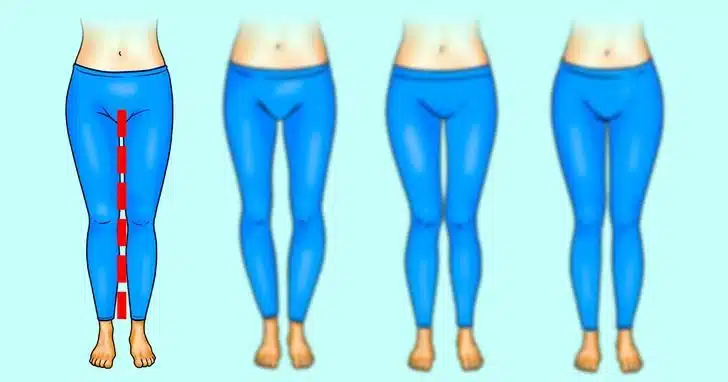They carry us up flights of stairs, across dance floors, and through the busiest days without a second thought. But when was the last time you really looked at your legs — not just for appearance, but for what their shape might be telling you?
Believe it or not, your leg alignment can give you real insights into your posture, joint health, and overall comfort. Let’s break it down in a simple, judgment-free way — just facts about your body that can help you move better and feel better.

Type 1: Naturally Straight Legs
What it looks like:
Your legs run straight from your hips down to your ankles. There’s no visible gap between your knees or thighs when standing.

What it suggests:
- Well-balanced bone alignment
- Even weight distribution when standing or walking
- Minimal strain on joints like hips and knees
What to do:
This is considered an ideal alignment. You don’t need to fix anything — just maintain the balance with supportive shoes**, regularstretching, and good posture habits.
Type 2: Bowed or “O-Shaped” Legs
What it looks like:
Even when your ankles touch, your knees stay apart. Your legs curve outward in an arc.
What it might mean:
- Could stem from early childhood bone development, like vitamin D deficiency (rickets)
- May cause knee strain or uneven pressure during walking
- Often linked to certain types of arthritis or natural skeletal variation
Helpful tips:
There’s no need to panic. Many people live comfortably with this leg shape. Consider low-impact exercises like swimming or cycling, and check in with a doctor or physiotherapist if you experience discomfort.
Type 3: Knock Knees or “X-Shaped” Legs
What it looks like:
Your knees touch, but your ankles remain apart. Your legs tilt slightly inward.
What it may indicate:
- Common in children and often self-corrects with age
- In adults, it may be a sign of flat feet, hip misalignment, or weakened muscles
- Sometimes contributes to balance issues or knee pain
What helps:
If pain or discomfort occurs, a visit to a podiatrist or physiotherapist can make a big difference. Custom orthotic insoles and strengthening exercises often help with realignment and comfort.
Type 4: Crossed or Severely Misaligned Legs
What it looks like:
Your legs cross noticeably, even when standing or sitting. The misalignment is more pronounced and may seem unnatural.
Possible causes:
- Pelvic imbalance or internal leg rotation
- Long-term poor posture habits
- Often linked to discomfort in the hips, knees, or lower back
What to consider:
A complete postural evaluation, along with core-strengthening and mobility training, can help correct alignment and relieve long-term pain. Don’t wait if you’re experiencing discomfort — early intervention makes a big difference.
*What If Your Legs Don’t Fit a “Perfect” Shape?
Here’s the truth: nobody’s legs are perfect, and they don’t need to be.
So if your legs ache, if standing feels uneven, or if something just doesn’t feel right — listen to your body. A well-fitted pair of shoes, a posture check, or a new stretching routine could be all it takes to feel better.